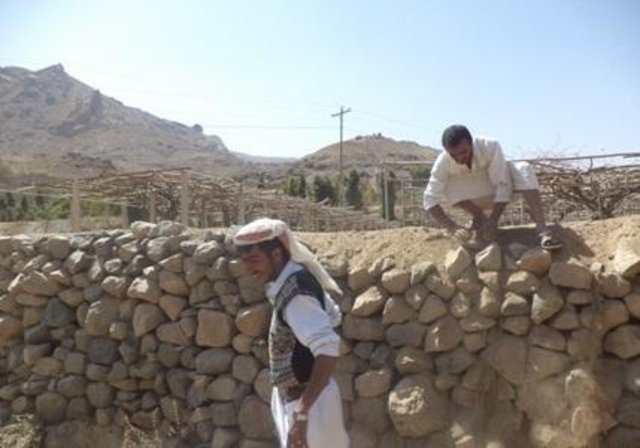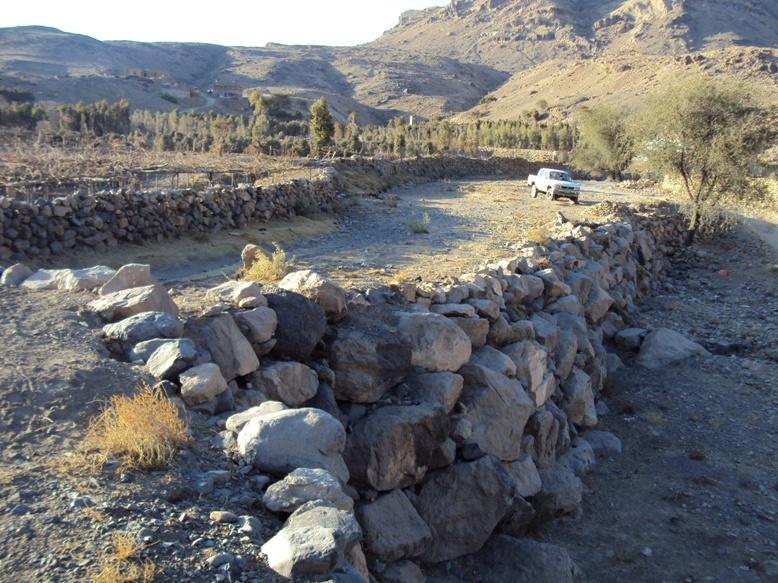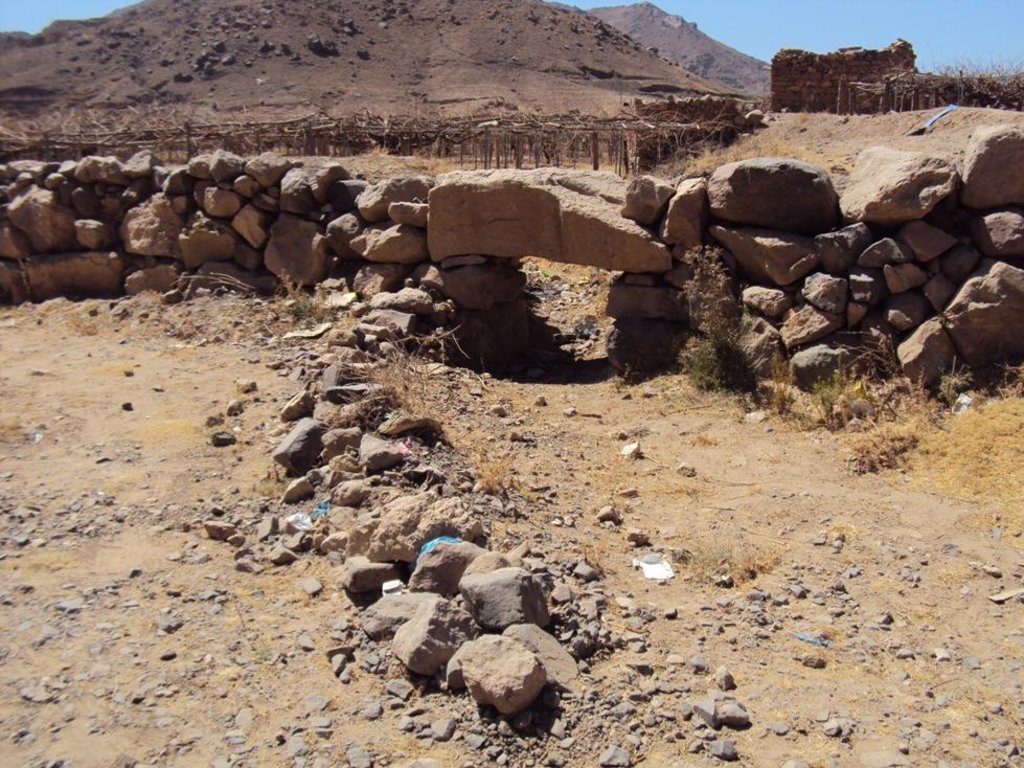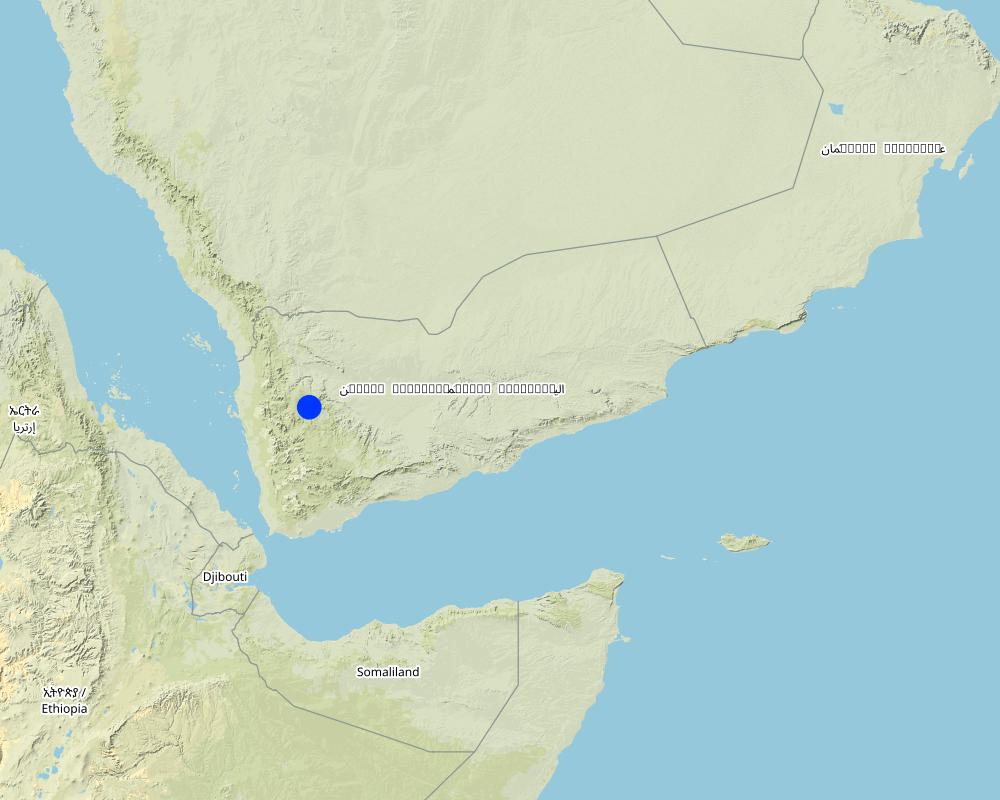Diversion construction with gates and distribution channels [也门]
- 创建:
- 更新:
- 编制者: ahmed algalal
- 编辑者: –
- 审查者: Alexandra Gavilano, David Streiff, Joana Eichenberger
الحواجز (الرزم) والبوابات والسواقي
technologies_1562 - 也门
- Diversion construction with gates and distribution channels: June 24, 2017 (inactive)
- Diversion construction with gates and distribution channels: June 24, 2017 (inactive)
- Diversion construction with gates and distribution channels: Aug. 13, 2019 (inactive)
- Diversion construction with gates and distribution channels: Nov. 25, 2022 (public)
查看章节
全部展开 全部收起1. 一般信息
1.2 参与该技术评估和文件编制的资源人员和机构的联系方式
SLM专业人员:
AL Hadrami Yahya
General Directorate of Irrigation
也门
SLM专业人员:
Sallam Ahmed
Agricultural Research and Extension Authority
也门
有助于对技术进行记录/评估的机构名称(如相关)
Agricultural Research and Extension Authority (AREA) - 也门有助于对技术进行记录/评估的机构名称(如相关)
General Directorate of Irrigation - 也门1.3 关于使用通过WOCAT记录的数据的条件
编制者和关键资源人员接受有关使用通过WOCAT记录数据的条件。:
是
1.5 参考关于SLM方法(使用WOCAT记录的SLM方法)的调查问卷

Rehabilitation of terraces and diversion construction with gates … [也门]
The rehabilitation of walls and outlets of the terraces and diversion construction with accessories from channels and gates are carried out by the local community in a regular way
- 编制者: ahmed algalal
2. SLM技术的说明
2.1 技术简介
技术定义:
The stone existed in the region are used for building diversion constructions to raise the level of wadi bed to the level of the inlet of the cultivated land that need to be irrigated from water harvesting in addition to distribution channels in the fields
2.2 技术的详细说明
说明:
Diversion construction (DC) technology is one the structural solutions using stones with slope and tan 30 to slow the water flow and to deposits the carried materials with water to allow water to pass throw the inlet (gate) to the fields that need to be irrigated without damaged mainly vines and qat crops. The site of DC must be built in direction of water flow to direct it to pass to the fields need to be irrigated to get a benefit from this water harvested the height of the DC should be equalled to the height of the cultivated land which ranges between 2-4 meter and the width is 1.5 meter and the length is ranged between 40-60 meter based on the width of wadi bed. The DC should not built totally in one time but should be gradually and by the time as a result of deposit be come at the same level of fields need to irrigated. Finally when the height of DC become equally to level of the field need to irrigated the gate should be determined according to water requirement of cultivated crops. After that distribution channels should built at 1-2 wide, 0.5- 0.8 height and 10-100 length. Such as this type of technology is considered a long term process in the past due to lack of equipments and implements. However now it can be done in short time if all requirement provided especially funds and equipments.
2.3 技术照片
2.5 已应用该技术的、本评估所涵盖的国家/地区/地点
国家:
也门
区域/州/省:
Sana
有关地点的进一步说明:
Bani Hushaish district
注释:
Total area covered by the SLM Technology is 20.6 km2.
Alrawanah Bani Hushaish, which is located on the eastern side of the capital Sanaa, and is about 16 km away
Map
×2.6 实施日期
如果不知道确切的年份,请说明大概的日期:
- 50多年前(传统)
2.7 技术介绍
详细说明该技术是如何引入的:
- 作为传统系统的一部分(> 50 年)
注释(项目类型等):
It is a very ancient technology but was rehabilitated in 1956 by the community
3. SLM技术的分类
3.1 该技术的主要目的
- 减少、预防、恢复土地退化
3.2 应用该技术的当前土地利用类型

农田
- 乔木与灌木的种植
乔木和灌木种植 - 指定作物:
- 葡萄
- Qat
每年的生长季节数:
- 1
具体说明:
Longest growing period in days: 90
注释:
Major land use problems (compiler’s opinion): Low productivity due to a lack of water (drought)
Major land use problems (land users’ perception): drought
Future (final) land use (after implementation of SLM Technology): Cropland: Ct: Tree and shrub cropping
3.3 由于技术的实施,土地使用是否发生了变化?

农田
- 乔木与灌木的种植
注释:
Future (final) land use (after implementation of SLM Technology): Cropland: Ct: Tree and shrub cropping
3.4 供水
该技术所应用土地的供水:
- 雨养
注释:
Water supply: Also mixed rainfed - irrigated and post-flooding
3.5 该技术所属的SLM组
- 横坡措施
- 引水和排水
3.6 包含该技术的可持续土地管理措施

结构措施
- S11:其它
注释:
Specification of other structural measures: Diversion construction with gates and distribution channels
3.7 该技术强调的主要土地退化类型

化学性土壤退化
- Cn:肥力下降和有机质含量下降(非侵蚀所致)

水质恶化
- Ha:干旱化
注释:
Secondary types of degradation addressed: Cn: fertility decline and reduced organic matter content
Main causes of degradation: floods, droughts, poverty / wealth (poverty)
Secondary causes of degradation: crop management (annual, perennial, tree/shrub) (up takes of major elements of fertility without subsistent)
3.8 防止、减少或恢复土地退化
具体数量名该技术与土地退化有关的目标:
- 减少土地退化
- 修复/恢复严重退化的土地
注释:
Secondary goals: mitigation / reduction of land degradation
4. 技术规范、实施活动、投入和成本
4.1 该技术的技术图纸
技术规范(与技术图纸相关):
Barrier cuts waterway with gates and distribution channels
Location: Alrawanah Uzlat. Bani Hushaish district
Technical knowledge required for field staff / advisors: high (Construction process requires skills and experiences)
Technical knowledge required for land users: low (Has sufficient expertise)
Main technical functions: water harvesting / increase water supply, water spreading
Secondary technical functions: increase in nutrient availability (supply, recycling,…), increase of groundwater level / recharge of groundwater, Reduce runoff
Structural measure: Diversion construction
Height of bunds/banks/others (m): 2 - 4
Width of bunds/banks/others (m): 1– 1.5
Structural measure: Gates
Height of bunds/banks/others (m): 0.5 -1
Width of bunds/banks/others (m): 0.7–1.2
Structural measure: Channels
Height of bunds/banks/others (m): 0.5–0.8
Width of bunds/banks/others (m): 1 - 2
Length of bunds/banks/others (m): 10-100
Construction material (stone): The diversion construction and the gates are constructed by stones existing in the region
Slope (which determines the spacing indicated above): 5%
作者:
AL-Galal
4.2 有关投入和成本计算的一般信息
具体说明成本计算所用货币:
- 美元
注明雇用劳工的每日平均工资成本:
7.00
4.3 技术建立活动
| 活动 | 时间(季度) | |
|---|---|---|
| 1. | Collecting stones and building barriers with gates | Before the rainy season |
| 2. | Building channels | Before the rainy season |
4.4 技术建立所需要的费用和投入
| 对投入进行具体说明 | 单位 | 数量 | 单位成本 | 每项投入的总成本 | 土地使用者承担的成本% | |
|---|---|---|---|---|---|---|
| 劳动力 | Collecting stones and building barriers with gates | persons/day/barrier | 225.0 | 7.0 | 1575.0 | 100.0 |
| 劳动力 | Building channels | persons/day/barrier | 7.0 | 7.0 | 49.0 | 100.0 |
| 设备 | Animal traction | barrier | 1.0 | 46.5 | 46.5 | 100.0 |
| 设备 | Tools | barrier | 1.0 | 46.5 | 46.5 | 100.0 |
| 设备 | Animal traction for channel building | barrier | 1.0 | 16.3 | 16.3 | 100.0 |
| 技术建立所需总成本 | 1733.3 | |||||
| 技术建立总成本,美元 | 1733.3 | |||||
注释:
Duration of establishment phase: 3 month(s)
4.5 维护/经常性活动
| 活动 | 时间/频率 | |
|---|---|---|
| 1. | Repair diversion construction and gates | annually after the rainy season |
| 2. | Clean channels | annually after the rainy season |
4.6 维护/经常性活动所需要的费用和投入(每年)
| 对投入进行具体说明 | 单位 | 数量 | 单位成本 | 每项投入的总成本 | 土地使用者承担的成本% | |
|---|---|---|---|---|---|---|
| 劳动力 | Repair diversion construction and gates | persons/day/unit | 13.0 | 7.0 | 91.0 | 100.0 |
| 劳动力 | Clean channels | persons/day/unit | 2.0 | 7.0 | 14.0 | 100.0 |
| 技术维护所需总成本 | 105.0 | |||||
| 技术维护总成本,美元 | 105.0 | |||||
注释:
Machinery/ tools: big hammers, shovel, soil leveller
Costs were calculated according to the current situation, for the barrier with a gate length of 60 meters and a height of 2 meters, and for the channels with an average length of 50 meters and a width of 1 meter.
With regard to maintenance has been developed a lump sum annually where maintenance was done at the current time using modern equipment and as a result of no collapse charges barriers and accessories in most years has been estimated annual sum for the purpose of maintenance in the event of any damage
4.7 影响成本的最重要因素
描述影响成本的最决定性因素:
- Transportation and gradient
- difficult roads
- cutting stones
5. 自然和人文环境
5.1 气候
年降雨量
- < 250毫米
- 251-500毫米
- 501-750毫米
- 751-1,000毫米
- 1,001-1,500毫米
- 1,501-2,000毫米
- 2,001-3,000毫米
- 3,001-4,000毫米
- > 4,000毫米
农业气候带
- 半干旱
Thermal climate class: temperate
5.2 地形
平均坡度:
- 水平(0-2%)
- 缓降(3-5%)
- 平缓(6-10%)
- 滚坡(11-15%)
- 崎岖(16-30%)
- 陡峭(31-60%)
- 非常陡峭(>60%)
地形:
- 高原/平原
- 山脊
- 山坡
- 山地斜坡
- 麓坡
- 谷底
垂直分布带:
- 0-100 m a.s.l.
- 101-500 m a.s.l.
- 501-1,000 m a.s.l.
- 1,001-1,500 m a.s.l.
- 1,501-2,000 m a.s.l.
- 2,001-2,500 m a.s.l.
- 2,501-3,000 m a.s.l.
- 3,001-4,000 m a.s.l.
- > 4,000 m a.s.l.
关于地形的注释和进一步规范:
Altitudinal zone: 2400 m a.s.l.
5.3 土壤
平均土层深度:
- 非常浅(0-20厘米)
- 浅(21-50厘米)
- 中等深度(51-80厘米)
- 深(81-120厘米)
- 非常深(> 120厘米)
土壤质地(表土):
- 中粒(壤土、粉土)
- 细粒/重质(粘土)
表土有机质:
- 中(1-3%)
如有可能,附上完整的土壤描述或具体说明可用的信息,例如土壤类型、土壤酸碱度、阳离子交换能力、氮、盐度等。:
Soil texture: Flood deposits
Topsoil organic matter: After falling vines leaves and grasses
Soil fertility is low - medium (output of the flood deposits)
Soil drainage / infiltration is medium - good
Soil water storage capacity is medium - high
5.4 水资源可用性和质量
地下水位表:
> 50米
地表水的可用性:
匮乏/没有
水质(未处理):
不良饮用水(需要处理)
关于水质和水量的注释和进一步规范:
Ground water table: 400 m
5.5 生物多样性
物种多样性:
- 低
5.6 应用该技术的土地使用者的特征
生产系统的市场定位:
- 混合(生计/商业)
非农收入:
- 收入的10-50%
相对财富水平:
- 贫瘠
- 平均水平
个人或集体:
- 团体/社区
机械化水平:
- 手工作业
- 畜力牵引
性别:
- 男人
说明土地使用者的其他有关特征:
Land users applying the Technology are mainly common / average land users
Difference in the involvement of women and men: Women could not do the hard work, therefore, men work on the farm and women do the house works.
Population density: > 500 persons/km2
Annual population growth: 3% - 4%
70% of the land users are average wealthy and own 90% of the land (moderate income).
30% of the land users are poor and own 10% of the land.
Level of mechanization: Also small tractors are used
5.7 应用该技术的土地使用者使用的平均土地面积
- < 0.5 公顷
- 0.5-1 公顷
- 1-2 公顷
- 2-5公顷
- 5-15公顷
- 15-50公顷
- 50-100公顷
- 100-500公顷
- 500-1,000公顷
- 1,000-10,000公顷
- > 10,000公顷
这被认为是小规模、中规模还是大规模的(参照当地实际情况)?:
- 中等规模的
注释:
0.45 - 0.9 ha fragmentation of tenure is the cause of the small ownership per household
5.8 土地所有权、土地使用权和水使用权
土地所有权:
- 个人,有命名
土地使用权:
- 个人
用水权:
- 社区(有组织)
注释:
There are three types of land ownership owned, Waqf, and a share at 70%, 20%, 10% respectively.
5.9 进入服务和基础设施的通道
健康:
- 贫瘠
- 适度的
- 好
教育:
- 贫瘠
- 适度的
- 好
技术援助:
- 贫瘠
- 适度的
- 好
就业(例如非农):
- 贫瘠
- 适度的
- 好
市场:
- 贫瘠
- 适度的
- 好
能源:
- 贫瘠
- 适度的
- 好
道路和交通:
- 贫瘠
- 适度的
- 好
饮用水和卫生设施:
- 贫瘠
- 适度的
- 好
金融服务:
- 贫瘠
- 适度的
- 好
6. 影响和结论性说明
6.1 该技术的现场影响
社会经济效应
生产
作物生产
生产故障风险
土地管理
水资源可用性和质量
饮用水的可用性
灌溉用水需求
收入和成本
农业收入
收入来源的多样性
社会文化影响
食品安全/自给自足
文化机会
SLM/土地退化知识
社会经济弱势群体的情况
livelihood and human well-being
注释/具体说明:
As a result of improving income and reducing the work load, the access to education is enhanced
生态影响
水循环/径流
水量
水的回收/收集
地表径流
地下水位/含水层
土壤
土壤水分
土壤流失
生物多样性:植被、动物
栖息地多样性
减少气候和灾害风险
洪水影响
其它生态影响
surface crusting
6.2 该技术的场外影响已经显现
水资源可用性
下游洪水
下游淤积
6.3 技术对渐变气候以及与气候相关的极端情况/灾害的暴露和敏感性(土地使用者认为的极端情况/灾害)
渐变气候
渐变气候
| 季节 | 增加或减少 | 该技术是如何应对的? | |
|---|---|---|---|
| 年温度 | 增加 | 好 |
气候有关的极端情况(灾害)
气象灾害
| 该技术是如何应对的? | |
|---|---|
| 局地暴雨 | 好 |
水文灾害
| 该技术是如何应对的? | |
|---|---|
| 比较和缓的(河道)洪水 | 不好 |
6.4 成本效益分析
技术收益与技术建立成本相比如何(从土地使用者的角度看)?
短期回报:
中性/平衡
长期回报:
积极
技术收益与技术维护成本/经常性成本相比如何(从土地使用者的角度看)?
短期回报:
稍微积极
长期回报:
非常积极
6.5 技术采用
- > 50%
如若可行,进行量化(住户数量和/或覆盖面积):
537 households covering 100 percent of the stated area
在所有采用这项技术的人当中,有多少人是自发的,即未获得任何物质奖励/付款?:
- 91-100%
注释:
537 land user families have adopted the Technology without any external material support
There is a moderate trend towards spontaneous adoption of the Technology
Comments on adoption trend: The technology is applied in the whole region, but the lack of capital is an obstacle for continuing conservation operations
6.7 该技术的优点/长处/机会
| 编制者或其他关键资源人员认为的长处/优势/机会 |
|---|
|
Harvesting flood waters How can they be sustained / enhanced? Continue maintenance operations |
|
Reduction of the runoff speed How can they be sustained / enhanced? Continue maintenance operations or introduce cement materials in the construction process to increase the ability to withstand various conditions |
|
Distribution of water on a regular basis How can they be sustained / enhanced? Maintenance of channels to ensure sustainability |
6.8 技术的弱点/缺点/风险及其克服方法
| 编制者或其他关键资源人员认为的弱点/缺点/风险 | 如何克服它们? |
|---|---|
| buried sediment distribution channels | lining channels for easy cleaning process |
| Construction costs and labour requirements are high | use modern equipment in the construction and maintenance processes |
| you need time for implementation | Use of modern equipment |
| Severe floodings can demolish barriers and gates | Use of cement materials |
7. 参考和链接
7.1 信息的方法/来源
7.2 参考可用出版物
标题、作者、年份、ISBN:
Report of traditional knowledge and customs (sallam, et al, 2008)General Census of Population, Housing and Establishment (Census, 2004). Guide of agricultural climate in Yemen (Al Khorasani, 2005).
可以从哪里获得?成本如何?
Agricultural Research and Extension Authority, AREACentral Bureau of StatisticsAgricultural Research and Extension Authority, AREA
链接和模块
全部展开 全部收起链接

Rehabilitation of terraces and diversion construction with gates … [也门]
The rehabilitation of walls and outlets of the terraces and diversion construction with accessories from channels and gates are carried out by the local community in a regular way
- 编制者: ahmed algalal
模块
无模块






